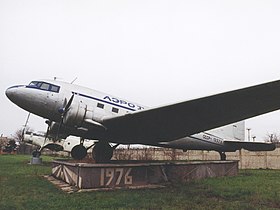Flight accident of the Lissunow Li-2 CCCP-L4207 of Aeroflot
| Flight accident of the Lissunow Li-2 CCCP-L4207 of Aeroflot | |
|---|---|
|
A structurally identical Lissunow Li-2 from Aeroflot |
|
| Accident summary | |
| Accident type | Lack of fuel |
| place |
Moscow Vnukovo Airport , Soviet Union |
| date | November 5, 1946, 6:55 p.m. |
| Fatalities | 1 |
| Survivors | 25th |
| Aircraft | |
| Aircraft type |
|
| operator |
|
| Mark |
|
| Departure airport |
Vilnius Airport , Lithuanian SSR |
| Destination airport |
Moscow Vnukovo Airport , Soviet Union |
| Passengers | 22nd |
| crew | 4th |
| Lists of aviation accidents | |
The aircraft accident of the Lissunow Li-2 CCCP-L4207 of Aeroflot was the third of three aircraft accidents that occurred on November 5, 1946 with Aeroflot aircraft . They were all on the approach to Vnukowo Airport and, due to chaotic conditions at the air traffic control there, were kept in the air until a safe landing was no longer possible. During the emergency landing of the Lissunow Li-2 CCCP-L4207, one passenger died, the other 25 occupants survived.
The Lissunow Li-2 CCCP-L4181 had already hit the ground 48 minutes earlier, and the Douglas C-47 CCCP-L946 25 minutes before the crash .
plane
The aircraft was a Lissunow Li-2 built in 1945 . The aircraft completed its maiden flight in May 1945. This aircraft type was a Soviet license replica of the Douglas DC-3 . The aircraft had the aircraft registration CCCP-L4207 and the serial number 18420908 . It was powered by two air-cooled 9-cylinder radial engines of the type M-62IR . By the time of the accident, the machine had had a cumulative operating performance of 1290 operating hours.
Passengers, crew and flight plan
With the Lissunow Li-2 CCCP-L4207 of Aeroflot, a passenger flight was to be carried out from Vilnius Airport to Moscow- Vnukowo on November 5th . The crew should then transfer the machine to Tbilisi for maintenance work . 22 passengers had started the flight, and there was also a four-person crew on board the machine, consisting of a flight captain, a first officer, a flight engineer and a flight attendant.
the accident
Difficult weather conditions had prevailed in the Moscow region for days. On November 5, 1946, the weather service at Vnukovo Airport published an inaccurate forecast that the visibility conditions in the Moscow region should improve between 3 p.m. and 5 p.m. The report irritated the crews of the approaching aircraft. In addition, air traffic control failed to reroute machines to alternate airports in Solnechnogorsk or Klin . This led to the fact that at times up to 17 machines were approaching Vnukowo at the same time. This lively flight operation overwhelmed the air traffic controllers in Wnukowo, they let many aircraft fly on holding patterns before they gave the clearance for the approach.
The Lissunow Li-2 CCCP-L4207 had been in holding patterns over Moscow for about 75 minutes until 17:45 on the instructions of air traffic control when it received clearance to land. The machine's automatic radio compass was defective and the approach was carried out using the surveillance radar. The pilots made five missed approaches and received a total of more than 60 radio bearings from the air traffic controller during this time. On the fifth approach, the machine ran out of fuel. After the Lissunow had lost altitude, it collided with light poles and fell to the ground at 18:55 on the edge of the airport premises, in front of the main entrance of the Wnukowo airport terminal and only 60 meters from the building. The cockpit collapsed, the fuselage tore apart between the 32nd and 33rd and between the 43rd and 44th ribs. One passenger died and several other passengers and crew were injured.
causes
The investigators essentially attributed the causes of the accident to five factors:
- An inadequately founded, incorrect weather forecast, which was created by the employees of the Wnukowo weather station between 12 and 5 p.m. The weather forecast was not created in accordance with the observed weather conditions and was not corrected in time, although the weather did not improve as predicted.
- The clearance of flights from the departure airports at the discretion of the persons responsible there without consulting Vnukovo Airport. Due to this fact, air traffic control in Vnukowo did not have a precise schedule for the arrival times of aircraft.
- The indiscipline of some airport managers at the departure airports, especially Vilnius airport, which, contrary to regulations, still has planes departing for Moscow at least 30 minutes before sunset. The Lissunow Li-2 CCCP-L4207 , which had started in Vilnius, had also started from Vilnius Airport with defective navigation devices. The numerous missed approaches of the machine due to these circumstances hindered flight operations at Vnukowo Airport.
- The poorly organized work processes at both Vnukovo Airport and Aeroflot.
- The disoriented approach of air traffic control at Vnukowo airport, which did not correct the omissions of the handlers at the departure airports by diversion of flights, so that a large number of aircraft were in the airspace above the airport when it got dark.
swell
- Aircraft accident report Li-2, CCCP-L4207 in the Aviation Safety Network
- Aircraft accident report Li-2, CCCP-L4207 on airdisaster.ru
- Operational history Li-2, CCCP-4207 on rzjets.net
